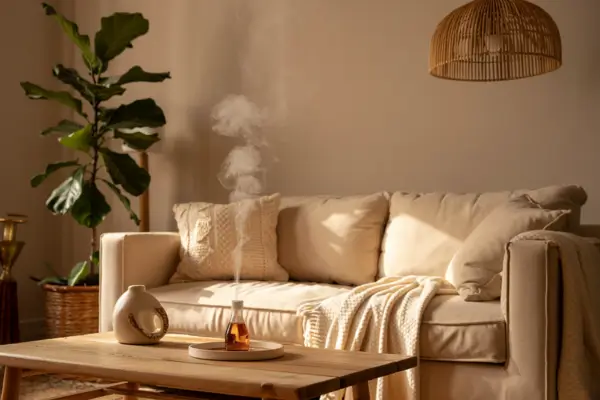In the world of interior design, aesthetics are just the beginning. While visual appeal captures attention, it’s the sensory experience that truly defines how a space feels. Sensory design focuses on creating environments that stimulate not only the eyes but also the touch, hearing, smell, and even taste—offering a holistic encounter with each room. When executed well, this approach transforms interiors into deeply immersive and emotionally resonant spaces.
What Is Sensory Design?
Sensory design is an approach that integrates all five senses to enhance the perception of space. It moves beyond traditional decoration by deliberately selecting materials, colors, lighting, textures, sounds, and even aromas to create a multi-dimensional experience. The goal is to promote comfort, well-being, and emotional engagement in a way that aligns with the purpose of the space—whether it’s a cozy bedroom, an inspiring office, or a welcoming living room.
Why Sensory Design Matters in Interior Spaces
Designing for the senses can profoundly affect mood and behavior. A visually pleasing room might initially impress, but one that also feels soft underfoot, smells like lavender, and plays gentle ambient sounds leaves a lasting emotional imprint. Sensory design helps reduce stress, improves concentration, encourages relaxation, and can even influence appetite and social interaction depending on the setting.
Engaging Sight: Color, Light, and Visual Flow
The visual component is still the cornerstone of design. Color psychology plays a major role—soft blues promote calm, earthy greens foster balance, and bold reds energize. Lighting also shapes perception. Natural light creates openness, while dimmable artificial lighting allows for personalized moods. Using a mix of ambient, task, and accent lighting adds depth and visual interest.
Tips for Visually Rich Spaces
Incorporate layered lighting schemes that support different activities. Use artwork, statement furniture, and focal walls to direct the eye across the space. Avoid visual clutter by ensuring there’s balance between patterns, shapes, and negative space. Visual hierarchy is key—let the most important elements draw attention first, then guide the viewer gradually through the room.
Touch and Texture: Engaging the Skin
Touch adds dimension to a space. Through varied textures, you can create an environment that feels luxurious, rustic, cozy, or sleek. Materials like velvet, wood, linen, leather, and stone offer tactile contrast and invite physical interaction. Textures should align with the mood: plush textiles for softness and comfort, harder materials for structure and clarity.
Practical Ideas for Tactile Design
Add throw pillows with different fabrics, or place a chunky knit blanket over the couch. Use rugs to soften hard floors and vary wall textures with wood paneling or limewash finishes. Even door handles, cabinet pulls, and upholstery should be chosen not just for looks, but also for how they feel when used.
Soundscapes: Designing with Acoustics
Sound is often overlooked in interior design, yet it plays a pivotal role in shaping how we feel within a space. A room’s acoustics can affect relaxation, concentration, and socialization. Sensory design considers not only the noise level but also the quality of sound—incorporating elements that reduce unwanted echoes while enhancing pleasant audio experiences.
How to Incorporate Sound Thoughtfully
To control acoustics, use area rugs, upholstered furniture, curtains, and acoustic wall panels. Add elements like indoor water features, ambient background music systems, or even nature soundtracks to create an auditory environment aligned with the room’s purpose. In a home office, calming music can promote productivity, while in a spa-inspired bathroom, soft water sounds add tranquility.
Scents and Aromatherapy: Engaging the Sense of Smell
Scent has a powerful link to memory and emotion. The olfactory sense can evoke comfort, energy, or calmness almost instantly. Integrating fragrance into a room creates atmosphere and contributes significantly to the overall sensory experience. This can be achieved through essential oil diffusers, scented candles, incense, or even fresh herbs and flowers.
Scent Pairings for Each Room
Choose scents that align with each space’s function. In the living room, woody or citrus aromas promote a welcoming environment. Bedrooms benefit from lavender or vanilla for relaxation. Kitchens can feel fresher with rosemary or lemon, while eucalyptus or peppermint energize bathrooms and home offices. Always opt for natural, non-toxic fragrance sources to maintain air quality.
Taste in Sensory Design: Not Just for Kitchens
Although taste is often tied to kitchens and dining rooms, sensory design can evoke flavors and culinary memories throughout the home. Displaying fruit bowls, herb gardens, or wine collections in open shelving can suggest a sensory narrative. Even the design of a coffee station or bar cart can contribute to the experience of taste.
Creative Ideas to Incorporate Taste
Use visually appealing ceramics or glassware on open shelves. Place a tea or espresso corner in your study with artisan cups and natural textures. Include cookbooks or framed food photography as subtle references to flavor. In entertaining areas, trays with snacks or infused water decanters invite tactile and gustatory interaction with the decor itself.
Lighting and Its Emotional Influence
Lighting directly affects mood and well-being. Soft, warm lighting tends to relax, while cooler tones stimulate focus and alertness. Sensory design uses lighting not just for function, but as an emotional tool to transform a room’s energy. Layering light sources and using dimmers offer control over intensity and ambiance throughout the day.
How to Design Lighting for the Senses
Incorporate a combination of ambient, task, and accent lighting. Use table lamps with fabric shades for softness, pendant lights to highlight specific zones, and LED strips for under-cabinet glow. Smart bulbs allow users to shift colors and temperatures to match their mood. Natural light should be maximized where possible, using sheer curtains or skylights to invite sunlight indoors.
Movement and Flow in Sensory Design
Sensory design also considers how people move through and interact with a space. A well-organized layout reduces stress and allows effortless transitions between activities. Flow is essential for comfort and clarity, helping residents and guests intuitively navigate and enjoy each room. Visual pathways and open space enhance the overall sensory balance of the home.
Designing for Flow and Freedom
Arrange furniture to create clear walkways and avoid visual clutter. Curved lines in layout or décor pieces can mimic natural forms and make movement feel organic. Rugs or floor materials can help define different zones without physical barriers. Encourage curiosity and interaction with open shelving, layered art, or multi-use spaces that evolve with different needs and moods.
Emotional Connections and Personal Touches
At the heart of sensory design is emotion. A space that stimulates the senses should also evoke feelings—calm, joy, nostalgia, or inspiration. This is achieved not just through colors and textures but through personal touches that make a home feel truly yours. Family photos, souvenirs from travels, inherited furniture, or handmade items carry stories and emotional weight that enrich your environment.
Infusing Personality into Sensory Design
Rather than following trends, choose elements that reflect your lifestyle, history, and aspirations. A sensory home is not sterile or showroom-like; it’s alive with layers of meaning. Create reading nooks, music corners, or cozy spaces that feel like emotional retreats. Personalization doesn’t clash with design—it completes it.
Sensory Design in Different Rooms
Each room in a home can benefit from a sensory approach, tailored to its function. A kitchen might prioritize scent and sound, while a bedroom focuses on touch and visual calm. The bathroom can become a spa-like haven with soft lighting, warm towels, and aromatic oils. Understanding the purpose of each room helps guide which senses to engage most prominently.
Examples by Room
Living Room: Use layered lighting, textured throws, and natural scents like cedar or citrus to promote relaxation and conversation.
Bedroom: Opt for calming color palettes, blackout curtains, soft bedding, and minimal noise for deep rest.
Kitchen: Highlight the smells of herbs or baking, integrate open shelving with tactile materials, and allow natural light to brighten the space.
Bathroom: Incorporate soothing sounds (like a water feature), candles, and plush materials for a luxurious feel.
The Role of Biophilic Design
Sensory design naturally overlaps with biophilic design, which centers on connecting humans with nature. Natural elements like wood, stone, and greenery are powerful sensory activators. Plants purify air and provide texture, while daylight regulates circadian rhythms and mood. Even views of nature or natural imagery can have a calming psychological effect.
Bringing Nature Indoors
Use live plants, botanical prints, natural materials, and water features. Open windows when possible to let in breeze and birdsong. Organic shapes and flowing lines further mimic nature’s rhythms. When incorporated thoughtfully, these elements awaken the senses and promote wellness on every level.
Technology and Sensory Balance
In a world saturated with digital screens and artificial environments, technology can feel at odds with sensory design. However, when used mindfully, it can enhance rather than detract from a multi-sensory atmosphere. The key lies in balance—leveraging tech to support comfort and functionality without overwhelming the senses.
Smart Solutions for Enhanced Living
Smart lighting systems allow users to adjust brightness and warmth according to the time of day or activity, helping to maintain circadian rhythms. Sound systems can fill a room with relaxing music or nature sounds, creating immersive auditory experiences. Voice-controlled assistants and hidden charging stations reduce visual clutter while increasing convenience.
The Psychology Behind Sensory Design
Sensory design is deeply rooted in psychology. Our senses are pathways to our memories, moods, and behaviors. Soft lighting reduces cortisol levels and creates calm; pleasant scents can lift our spirits or reduce anxiety; textures affect our perception of comfort and safety. Understanding these links helps designers make choices that support mental and emotional wellbeing.
Creating Spaces That Heal
Sensory environments can aid recovery, improve focus, and foster emotional stability. This is particularly relevant in therapeutic and educational spaces, but also at home. Children, for instance, benefit from sensory zones that promote play, exploration, and self-regulation. Adults can use sensory cues to shift gears—rest, socialize, or concentrate—more effectively throughout the day.
Final Thoughts: Designing for the Human Experience
Sensory design goes beyond appearance—it’s a practice rooted in how spaces make us feel, behave, and connect. When interiors stimulate our senses thoughtfully, they promote well-being, creativity, calm, and joy. This approach transforms homes into personal sanctuaries, workplaces into inspiring hubs, and everyday moments into richer experiences.
Designing with the senses in mind is not just a trend—it’s a return to human-centered living. Whether through soft textures, calming scents, gentle sounds, or natural light, each detail contributes to a space that supports your emotional and physical health. In the end, it’s not only about how your home looks—it’s about how it makes you feel, every single day.




